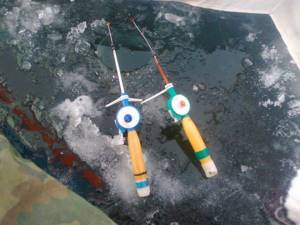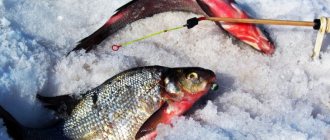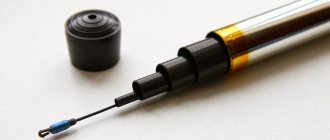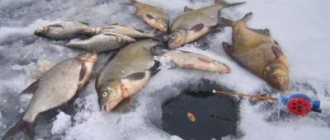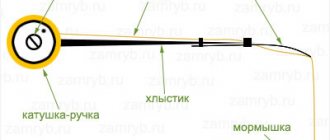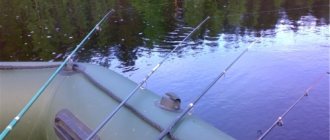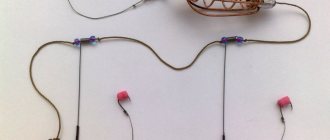Fishing in winter differs from summer: fishing at low temperatures is less tolerated by anglers, the hole quickly becomes covered with a layer of ice, and fish behavior changes depending on the hunting season. Finding fish in winter is difficult: all prey is close to the bottom. For such cases, you can purchase it in a specialized store or use scrap materials to make a nod for a winter fishing rod with your own hands, which can easily cope with this problem.
Why do you need a nod?
The ability to quickly respond to a bite and control the vibrations of the bait are functions of the nod that increase the chances of a catch. The nod signals the fisherman about a bite. In winter, fishing gear experiences harsh weather conditions: materials must be resistant to temperature changes, withstand numerous bends and not deform.
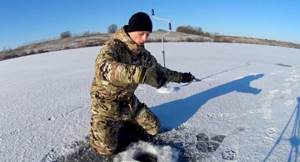
Requirements that the gatehouse must meet:
- resistance to natural reactions (wind, snow, humidity);
- high wear resistance (to minimize replacement frequency);
- low cost;
- availability of materials for installation;
- the ability to monitor bait wiring.

Making a nod for a winter fishing rod that will suit individual fishing conditions, the size of the prey, and the nature of the bait is not difficult. It is enough to stock up on the necessary materials and show imagination and dexterity.
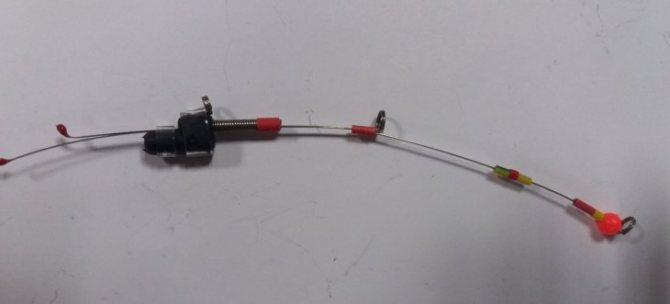
We present to you a handmade winter fishing rod made by Palych, an expert at the online fishing store “Narodnaya Fishing”.
This fishing rod is an analogue of fashionable and expensive electronic winter fishing rods, without being electronic.
Unlike electronic fishing rods, “Narodny Samotryas-1” is easy to operate, does not require additional costs for batteries, and has much less weight and price.
The flexible whip of the “People's Samotryas-1” allows you to dampen fish jerks, protect your tackle from breaking and save a trophy specimen.
“People's self-shaker-1” allows you, with little effort, to make high-frequency vibrations with a jig, which cannot be repeated with a conventional fishing rod, which attracts even inactive fish and your hand does not get tired.
“People's Self Shaker-1” will make the game a professional bait even for beginners and will allow you to interest inactive fish.
With the help of "People's Self Shaker-1" you will learn how to fish with reelless gear.
"People's Self Shaker-1" will allow you to make countless types of wiring and combine them.
“People's Self Shaker-1” is made specifically to fit the dimensions of standard and most popular winter fishing boxes; it does not need to be disassembled to put it inside.
“People's Samotryas-1” is an exclusive handmade product. You will surprise other anglers with your tackle. The performance of each rod is checked by our experts.
"People's Samotryas-1" has been successfully tested and tested by the "People's Fishing" team in the reservoirs of Central Russia.
"People's Samotryas-1" is completely ready for use.
You can see the work of the “People’s Samotryas”, equipped with different gear, and in different conditions, using these links:
1. Fishing for small roach and perch in shallow water using a folk jig with a nozzle
2. Fishing with the People's Self Shaker in the reservoir for white bream at a depth of 8 meters using no-bait tackle Parovoz
3. Techniques and tactics of fishing with a folk shaker
4. Fishing results on the People's Samotryas. White bream on a reservoir in the middle of nowhere.
5. Fishing results on the People's Samotryas. Roach and bream on the reservoir in March.
6. Comparison of the People's Self Shaker and a regular winter fishing rod.
7. People's self-shaking. Main types of postings.
8. A little more about the People's Samotryas (answers to frequently asked questions)
ATTENTION!!! The number of rods is limited.
Choosing a nod for a winter fishing rod
To choose the right winter fishing rod, you need to decide on the bait and type of fishing. A specific signaling device is suitable for each bait. The rigidity of the guard depends on the material used, thickness and length.

The design of the nod includes three components:
- the basis is a thread of lavsan, etc.;
- the rubber washer is the attachment point to the whip;
- The role of a signaling device is performed by a strip of paint.
Materials for making nods
Nods made of steel plate are the most popular type of alarms used by fishermen. At the end of such equipment there are cambrics. One of the positive properties that a nod made from this material has is the ability to adjust to fit the weight of the bait and withstand the wind. The disadvantages include the lack of adjustment of jig vibration and low service life.
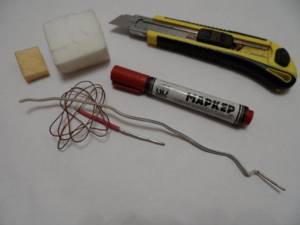
Lavsan nods are made of polymer material, which is thin and durable even when exposed to low temperatures. They are very sensitive, reacting to the slightest touch of fish on the bait. They are not able to withstand heavy weight due to their small thickness, so they are not suitable for lure fishing.
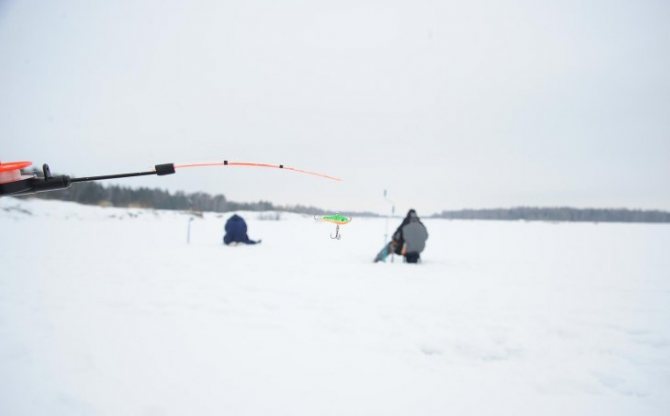
Boar bristle nods are not particularly popular among fishermen, but at shallow depths or in still water this type of nod is most suitable. They have excellent resistance to strong winds due to the light of a small cross-section, but in severe frosts they quickly become unusable.

Nipple rubber nods are used extremely rarely due to the material they are made of: in the cold it loses its elasticity and freezes when it gets wet.

In addition, wiring with a rubber nipple nod gives poor results and resembles shaking rather than playing. They are used in cases where a more suitable signaling device is not at hand.
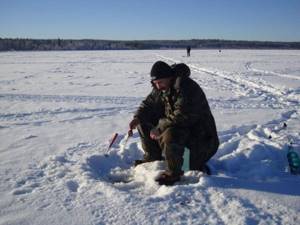
Carbon fiber nods are made from material intended for the production of float rods and have earned the trust of fans of reelless fishing. They resist the wind perfectly and accurately indicate bites. Disadvantages include fragility, but manufacturing technologies are developing, and the future lies with this type of nod.
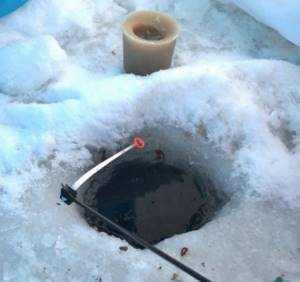
Method of winter fishing for perch using self-shaking
Samotryas is a spinner for vertical trolling, which is common in the Middle Urals and Western Siberia. The body of this spoon is massive, round, curved in the lower third; A rather long and very sharp hook without a barb is soldered into it, placed at an acute angle to the spoon so that it is not visible from the opposite (outer) side. With the same dimensions (length and width) as a regular spoon, it is relatively heavier, which allows it to be used at greater depths.
This bait owes its name not only to the fact that it is led in the water with twitching and shaking, as it should be with vertical lures, but also to the fact that the caught fish is simply shaken off the hook.
The holes are usually prepared the day before. Leaving the ice, the fisherman clears promising holes and lowers the bait (1-2 handfuls of jigs) and sprinkles them with snow. Perch fishing begins at dawn, moving from hole to hole.
The fisherman’s movements are peculiar: in his left hand he holds a small, about half a meter, stick, used to regularly clear the hole of ice crust and to help with fishing. The fisherman holds a fishing rod in his right hand, with which (with an upward swing) he hooks the fish when he bites. If the hook is successful, the fisherman continues the movement of his hand, simultaneously picking up the fishing line with a stick and pulling it to the left until it stops. At this moment, the fishing line is picked up by the fishing rod and pulled to the right. With these alternating strokes to the left and right, the fishing line must be tensioned, which is why vertical trolling with a “self-shaking” is most effective when fishing from a depth of 2-3 m. The slightest weakening of the fishing line when fishing is inevitably and immediately punished by the loss of fish.
As the fish moves to the lower layers of the water and the ice thickness increases, the length of the fishing line increases and the angler has to make much more hand movements. The freed spoon is immediately thrown back into the hole, removing the line alternately from the fishing rod and from the stick.
The frequency and amplitude of the spinner's oscillations are individual: at great depths, the swing and shaking of the spinner should be relatively short, they should be alternated with very small shaking, and, until the bites begin, with two or three long ones, for the entire span of the arm, driving the spinner away as much as possible further to the side, “calling out the fish,” as anglers say. It is useful, especially when catching pike perch and large perch, to occasionally place the spoon on the bottom, raise a cloud of turbidity, then jerk the bait slightly and hold it for a few seconds. The perch reliably takes the lure only at the moment of its transition to rest, when it oscillates slightly.
DIY nod for winter fishing
Fans of fishing in winter consider making nods as a hobby and a desire to create a multifunctional signaling device for themselves.
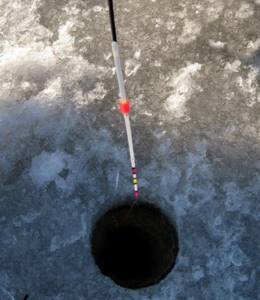
There are many ways to assemble a winter fishing rod with a nod, however, each self-made guard will have its own characteristics, advantages and disadvantages of use.
- nod made from a clock spring;
- nod from X-ray film;
- nod made of lavsan;
- Shcherbakov signaling device;
- from a coiled spring;
- nod "cracker"
- nod "snot"
